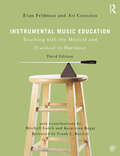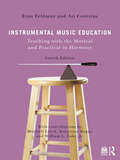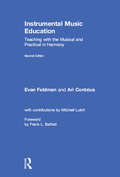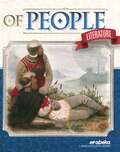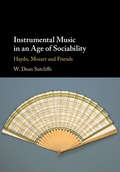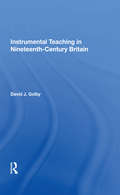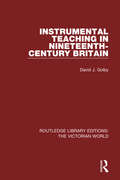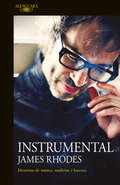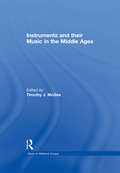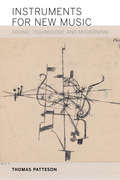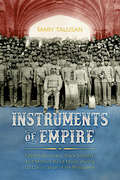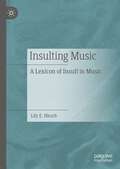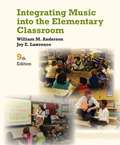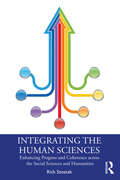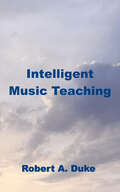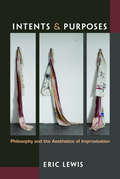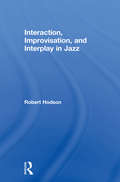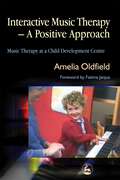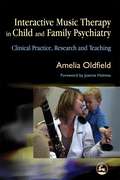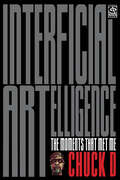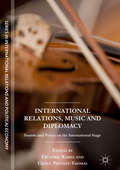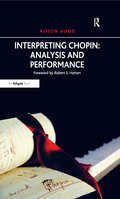- Table View
- List View
Instrumental Music Education: Teaching with the Musical and Practical in Harmony
by Evan Feldman Ari ContziusInstrumental Music Education: Teaching with the Musical and Practical in Harmony, Third Edition, is intended for college instrumental music education majors studying to be band and orchestra directors at the elementary, middle school, and high school levels. This textbook presents a research-based look at the topics vital to running a successful instrumental music program, while balancing musical, theoretical, and practical approaches. A central theme is the compelling parallel between language and music, including "sound-to-symbol" pedagogies. Understanding this connection improves the teaching of melody, rhythm, composition, and improvisation. The companion website contains over 120 pedagogy videos for wind, string, and percussion instruments performed by professional players and teachers, over 50 rehearsal videos, rhythm flashcards, and two additional chapters: "The Rehearsal Toolkit" and ''Job Search and Interview." It also includes over 50 tracks of acoustically pure drones and demonstration exercises for use in rehearsals, sectionals, and lessons. New to this edition: A new chapter on teaching beginning band using sound-to-symbol pedagogies Expanded coverage for strings and orchestra, including a new chapter on teaching beginning strings A new chapter on conducting technique Expanded material on teaching students with disabilities Concert etiquette and the concert experience Expanded coverage on the science of learning, including the Dunning-Krueger effect and the effective use of repetition in rehearsal Techniques for improving students’ practice habits
Instrumental Music Education: Teaching with the Musical and Practical in Harmony
by Evan Feldman Ari ContziusInstrumental Music Education: Teaching with the Theoretical and Practical in Harmony, Fourth Edition, is intended for college instrumental music education majors studying to be band and orchestra directors at the elementary, middle school, and high school levels. Its fundamental goal is to prepare music teachers for the real world, looking at the topics vital to running a successful instrumental music program, while balancing musical, theoretical, and practical approaches. A central theme is the compelling parallel between language and music, including "sound-to-symbol" pedagogies. Understanding this connection improves the teaching of melody, rhythm, composition, and improvisation.Unique to this book is its research-based approach; its overview of a variety of educational sites is more extensive than any similar resource. Its accompanying Instructor and Student Resources include over 120 videos filmed with high school, college, and community concert, pedagogy videos for all wind and string instruments, presented by professional players and teachers.New to this edition: A section on social emotional learning (SEL) An introduction to culturally responsive teaching Additional discussion of teaching composition, improvisation, and creativity Expanded discussion of the advantages, challenges, and philosophies surrounding teaching ensembles other than band and orchestra Many updates and additions throughout the text Offering best practices rooted in experience and clear, balanced coverage of pedagogical, philosophical, and administrative issues, this textbook effectively prepares future band and orchestra instructors to teach at all levels.
Instrumental Music Education: Teaching with the Musical and Practical in Harmony (Second Edition)
by Evan Feldman Ari Contzius Mitchell Lutch<p>Instrumental Music Education: Teaching with the Musical and Practical in Harmony, 2nd Edition is intended for college instrumental music education majors studying to be band and orchestra directors at the elementary, middle school, and high school levels. This textbook presents a research-based look at the topics vital to running a successful instrumental music program, while balancing musical, theoretical, and practical approaches. A central theme is the compelling parallel between language and music, including "sound-to-symbol" pedagogies. Understanding this connection improves the teaching of melody, rhythm, composition, and improvisation. <p>The companion website contains over 120 pedagogy videos for wind, string, and percussion instruments, performed by professional players and teachers, over 50 rehearsal videos, rhythm flashcards, and two additional chapters, "The Rehearsal Toolkit," and "Job Search and Interview." It also includes over 50 tracks of acoustically pure drones and demonstration exercises for use in rehearsals, sectionals and lessons. <p>New to this edition: <p> <li> Alternative, non-traditional ensembles: How to offer culturally relevant opportunities for more students, including mariachi, African drumming, and steel pans. <li> More learning and assessment strategies <li> The science of learning and practicing: How the brain acquires information <li> The philosophies of Orff and El Sistema, along with the existing ones on Kodály, Suzuki, and Gordon. <li> The Double Pyramid of Balance: Francis McBeth’s classic system for using good balance to influence tone and pitch. <li> Updated information about copyright for the digital age</li> </p>
Instrumental Music for Dyslexics: A Teaching Handbook
by Sheila OglethorpeInstrumental Music for Dyslexics is written mainly for music teachers. It describes dyslexia in layman's terms and explains how the various problems which a dyslexic may have can affect all aspects of learning to play a musical instrument. It alerts the music teacher with a problem pupil to the possibilities of that pupil's having some form of dyslexia. Although Sheila Oglethorpe is primarily a piano teacher the general principle behind most, if not all, the suggestions is such that they can be adapted for use by other instrumentalists. The book presents ways in which the music teacher can contribute to the self esteem and thereby the general welfare of the dyslexic pupil who is often musically gifted and has much to offer. The book will also be of interest to dyslexia specialists who have hitherto directed their concentration towards the language-based problems of the dyslexic.
Instrumental Music in Late Eighteenth-Century Naples: Politics, Patronage and Artistic Culture
by Anthony R. DelDonnaThe music of early modern Naples and its renowned artistic traditions remain a fruitful area for scholars in eighteenth-century studies. Contemporary social, political, and artistic conditions had stimulated a significant growth of music, musicians and culture in the Kingdom of Naples from the beginning of the seventeenth century. Although eighteenth-century Neapolitan opera is well documented in scholarship, historians have paid much less attention to the simultaneous cultivation of instrumental genres. Yet the culture of instrumental music grew steadily and by its end became an exclusive area of focus for the royal court, a remarkable departure from past norms of patronage. By bridging this gap, Anthony R. DelDonna brings together diverse fields, including historical musicology, music theory, Neapolitan and European history. His book investigates the wide-ranging role of instrumental genres within late eighteenth-century Neapolitan culture and introduces readers to new material, including recently discovered instrumental works of Paisiello, Cimarosa and Pleyel.
Instrumental Music in an Age of Sociability: Haydn, Mozart and Friends
by W. Dean SutcliffeSociability may be a key term of reference for eighteenth-century studies as a whole, but it has not yet developed an especially strong profile in music scholarship. Many of the associations that it brings do not fit comfortably with a later imperative of individual expression. W. Dean Sutcliffe invites us to face up to the challenge of re-evaluating the communicative rationales that lie behind later eighteenth-century instrumental style. Taking a behavioural perspective, he divides sociability into 'technical' and 'affective' realms, involving close attention both to particular recurring musical patterns as well as to some of the style's most salient expressive attributes. The book addresses a broad span of the instrumental production of the era, with Haydn as the pivotal figure. Close readings of a variety of works are embedded in an encompassing consideration of the reception of this music.
Instrumental Teaching in Nineteenth-Century Britain (Music In Nineteenth-century Britain Ser.)
by David GolbyIt is a truth widely acknowledged that, while part of a uniquely diverse and vibrant musical environment, the achievements of home-grown British instrumentalists in the nineteenth century gave little cause for national pride. Drawing together information from a wide variety of primary and secondary sources, in particular treatises and tutors, David Golby demonstrates that while Britain produced many fewer instrumental virtuosi than its foreign neighbours, there developed a more serious and widespread interest in the cultivation of music throughout the nineteenth century. Taking a predominantly historical approach, the book moves from a discussion of general developments and issues to a detailed examination of violin pedagogy, method and content which is used as a guide to society's influence on cultural trends and informs the discussion of other instruments and institutional training that follows. In the first study of its kind Dr Golby examines in depth the inextricable links between trends in society, education and levels of achievement. He also extends his study beyond professional and 'art' music to incorporate the hugely significant amateur and 'popular' spheres. To provide a contextual framework for the study, the book includes a chronology of developments in 19th-century British music education, and a particularly useful feature for future researchers in this field is a representative chronology of principal British instrumental treatises 1780-1900 that features over 700 items.
Instrumental Teaching in Nineteenth-Century Britain (Routledge Library Editions: The Victorian World)
by David GolbyFirst published in 2004, this book demonstrates that while Britain produced many fewer instrumental virtuosi than its foreign neighbours, there developed a more serious and widespread interest in the cultivation of music throughout the nineteenth century. Taking a predominantly historical approach, the book moves from a discussion of general developments and issues to a detailed examination of violin pedagogy, method and content, which indicates society’s influence on cultural trends and informs the discussion of other instruments and institutional training that follows. In the first study of its kind, it examines in depth the inextricable links between trends in society, education and levels of achievement. It also extends beyond profession and ‘art’ music to amateur and ‘popular’ spheres. A useful chronology of developments in nineteenth-century British music education is also included. This book will be of interest to those studying the history of instrumental teaching and Victorian music.
Instrumental: A Memoir Of Madness, Medication, And Music
by James RhodesAs memórias de um aclamado pianista que se salvou do inferno da depressão e do abuso graças à música. Uma inspiradora história de redenção. Mais de 100 mil leitores se deixaram tocar por este testemunho de superação. «Abusaram de mim aos seis anos. Internaram-me num hospital psiquiátrico. Fui viciado em drogas e álcool. Tentei suicidar-me cinco vezes. Separaram-me do meu filho. Mas não vou falar disso. Vou falar de música. Porque Bach salvou-me a vida. E eu amo a vida.» James confiava naquele homem simpático. Porque não haveria de confiar? Era seu professor na escola primária. A primeira oferta foi uma caixa de fósforos, um maravilhoso objecto de desejo para um menino de seis anos. Seguiram-se outros pequenos presentes, acompanhados de sorrisos, palavras de incentivo, gestos atenciosos. Depois começaram os abusos sexuais, que duraram vários anos, sem que ninguém na escola e na família se apercebesse. Quando terminaram, James afundou-se progressivamente num abismo de relações obsessivas, hospitais psiquiátricos e vícios destrutivos, uma espiral que o afastou do piano, para o qual revelara talento precoce. Mas foi um adágio de Bach, escutado durante um internamento, que o salvou de anos no fundo do poço. Ao descobrir que também os génios por trás das mais sublimes composições eram homens com existências dramáticas, James encontrou nos pequenos milagres da música o reduto para sobreviver aos seus demónios pessoais. Um encontro inesperado com um desconhecido deu-lhe o impulso de que James precisava para reencontrar o seu caminho na música. Hoje é um pianista aclamado em todo o mundo. Instrumental é um testemunho apaixonado e apaixonante, negro e luminoso, sobre o poder terapêutico da música e a sua capacidade de transformar as nossas vidas, mas também, e sobretudo, sobre a nossa capacidade de reinvenção. Os elogios da crítica: «Rhodes prova que a arte e a beleza podem ajudar; prova que a vida pode ser conquistada dia a dia.»El País «Estávamos a precisar deste livro.»Huffington Post UK «O que distingue este livro é a forma como ele confronta os aspectos indizíveis do abuso sexual das crianças e das doenças mentais... Muitos destes pensamentos são tabu e é preciso clareza, coragem e inteligência para os expressar de forma tão directa e honesta como Rhodes faz.»Independent «Bem escrito, coloquial, tão excitante quanto devastador. Como documento dos efeitos do abuso de crianças é, provavelmente, insuperável.»Sunday Times «Nunca li um testemunho tão sábio sobre o que é ser-se vítima... É visceral e palpável... Das páginas mais impactantes que li nos últimos tempos.»Scotland on Sunday «Uma obra impressionante. Combina uma precisão vívida e obsessiva com uma energia torrencial.»Guardian «Uma leitura dura, avassaladora.»The Times «Poderoso.»New Statesman «Uma vida que tinha de ficar registada.»Spectator
Instrumentalists and Renaissance Culture, 1420–1600
by Coelho, Victor and Polk, Keith Victor Coelho Keith PolkThis innovative and multi-layered study of the music and culture of Renaissance instrumentalists spans the early institutionalization of instrumental music from c. 1420 to the rise of the basso continuo and newer roles for instrumentalists around 1600. Employing a broad cultural narrative interwoven with detailed case studies, close readings of eighteen essential musical sources, and analysis of musical images, Victor Coelho and Keith Polk show that instrumental music formed a vital and dynamic element in the artistic landscape, from rote function to creative fantasy. Instrumentalists occupied a central role in courtly ceremonies and private social rituals during the Renaissance, and banquets, dances, processions, religious celebrations and weddings all required their participation, regardless of social class. Instrumental genres were highly diverse artistic creations, from polyphonic repertories revealing knowledge of notated styles, to improvisation and flexible practices. Understanding the contributions of instrumentalists is essential for any accurate assessment of Renaissance culture.
Instruments and their Music in the Middle Ages (Music In Medieval Europe Ser.)
by Timothy J. McGeeThis is a collection of twenty-nine of the most influential articles and papers about medieval musical instruments and their repertory. The authors discuss the construction of the instruments, their playing technique, the occasions for which they performed and their repertory. Taken as a whole, they paint a very broad, as well as detailed, picture of instrumental performance during the medieval period.
Instruments for New Music: Sound, Technology, and Modernism
by Thomas PattesonAt publication date, a free ebook version of this title will be available through Luminos, University of California Press' new Open Access publishing program for monographs. Visit www.luminosoa.org to learn more. Player pianos, radio-electric circuits, gramophone records, and optical sound film--these were the cutting-edge acoustic technologies of the early twentieth century, and for many musicians and artists of the time, these devices were also the implements of a musical revolution. Instruments for New Music traces a diffuse network of cultural agents who shared the belief that a truly modern music could be attained only through a radical challenge to the technological foundations of the art. Centered in Germany during the 1920s and 1930s, the movement to create new instruments encompassed a broad spectrum of experiments, from the exploration of microtonal tunings and exotic tone colors to the ability to compose directly for automatic musical machines. This movement comprised composers, inventors, and visual artists, including Paul Hindemith, Ernst Toch, Jörg Mager, Friedrich Trautwein, László Moholy-Nagy, Walter Ruttmann, and Oskar Fischinger. Patteson's fascinating study combines an artifact-oriented history of new music in the early twentieth century with an astute revisiting of still-relevant debates about the relationship between technology and the arts.
Instruments in the History of Western Music (Routledge Revivals)
by Karl GeiringerOriginally published in 1943 and subsequently as a revised and enlarged edition in 1978, Musical Instruments has long been held in high regard, not only for its erudition, but for its originality of approach. By relating the instruments to their time and each other, epoch by epoch, the author sheds fresh light on their evolution and enables the reader to follow their ups and downs against the changing background of taste and fashion. Each chapter is introduced with an account of the musical forms and artistic trends of the period, before considering in detail the instruments that gave them expression. The reader is carried along, from the magical-sacred beginnings of music, through the instruments of antiquity, the experiments of the Middle Ages and the Renaissance, the refined instruments of the Baroque and classical periods, down to those of the Romantic age and its aftermath, including the modern era with its electronic synthesizers. The book is completed by an Appendix on the acoustics of music and amply illustrated by nearly 100 pictures and diagrams.
Instruments of Empire: Filipino Musicians, Black Soldiers, and Military Band Music during US Colonization of the Philippines
by Mary TalusanAt the turn of the twentieth century, the United States extended its empire into the Philippines while subjugating Black Americans in the Jim Crow South. And yet, one of the most popular musical acts was a band of “little brown men,” Filipino musicians led by an African American conductor playing European and American music. The Philippine Constabulary Band and Lt. Walter H. Loving entertained thousands in concert halls and world’s fairs, held a place of honor in William Howard Taft’s presidential parade, and garnered praise by bandmaster John Philip Sousa—all the while facing beliefs and policies that Filipinos and African Americans were “uncivilized.” Author Mary Talusan draws on hundreds of newspaper accounts and exclusive interviews with band members and their descendants to compose the story from the band’s own voices. She sounds out the meanings of Americans’ responses to the band and identifies a desire to mitigate racial and cultural anxieties during an era of overseas expansion and increasing immigration of nonwhites, and the growing “threat” of ragtime with its roots in Black culture. The spectacle of the band, its performance and promotion, emphasized a racial stereotype of Filipinos as “natural musicians” and the beneficiaries of benevolent assimilation and colonial tutelage. Unable to fit Loving’s leadership of the band into this narrative, newspapers dodged and erased his identity as a Black American officer. The untold story of the Philippine Constabulary Band offers a unique opportunity to examine the limits and porousness of America’s racial ideologies, exploring musical pleasure at the intersection of Euro-American cultural hegemony, racialization, and US colonization of the Philippines.
Insulting Music: A Lexicon of Insult in Music
by Lily E. HirschInsulting Music explores insult in and around music and demonstrates that insult is a key dimension of Western musical experience and practice. There is insult in the music we hear, how we express our musical preferences, as well as our reactions to settings and sites of music and music making. More than that, when music and insult overlap, the effects can both promote social justice or undermine it, foster connection or break it apart. The coming together of music and insult shapes our sense of self and view of other people, underlining and constructing difference, often in terms of race and gender. In the last decade, music’s power dynamics have become an increasingly important concern for music scholars, critics, and fans. Studying musicians such as Frank Zappa, Nickleback, Taylor Swift, and the Insane Clown Posse, and musical phenomena such as musician jokes, the use of music to torture people, and the playing of music in restaurants, this book shows the various and contradictory ways insults are used to negotiate those existing dynamics in and around music.
Integrating Music into the Elementary Classroom
by William M. Anderson Joy E. LawrenceThe market-leading text for the Elementary School Music Methods course, INTEGRATING MUSIC INTO THE ELEMENTARY CLASSROOM was the first to emphasize the theme of integrating music throughout the school day. Anderson and Lawrence show future educators how to make music an effective part of the entire elementary curriculum. The text introduces songs, instruments, sources of age-appropriate music, and methods of making music in a multicultural environment -- making it perfect for students with no prior knowledge of music fundamentals. With easy techniques for teaching young children how to sing, play instruments, move to music, create music, listen to music, and understand music, this text relates music to all subject areas. Notably, the authors provide sample lesson plans for kindergarten through sixth grade, along with more than 150 songs from different cultures and historical periods.
Integrating the Human Sciences: Enhancing Progress and Coherence across the Social Sciences and Humanities
by Rick SzostakWhat if we recognized that the human sciences collectively investigate a few dozen key phenomena that interact with each other? Can we imagine a human science that would seek to stitch its understandings of this system of phenomena into a coherent whole? If so, what would that look like? This book argues that we are unlikely to develop one unified "theory of everything." Our collective understanding must then be a "map" of the myriad relationships within this large – but finite and manageable – system, coupled with detailed understandings of each causal link and of important subsystems. The book outlines such a map and shows that the pursuit of coherence – and a more successful human science enterprise – requires integration, recognizing the strengths and weaknesses of different methods and theory types, and the pursuit of terminological and presentational clarity. It explores how these inter-connected goals can be achieved in research, teaching, library classification, public policy, and university administration. These suggestions are congruent with, and yet enhance, other projects for reform of the human sciences. This volume is aimed at any scholar or student who seeks to comprehend how what they study fits within a broader understanding.
Intelligent Music Teaching: Essays on the Core Principles of Effective Instruction
by Robert A. DukeIn this collection of insightful essays, the author describes fundamental principles of human learning in the context of teaching music. Written in an engaging, conversational style, the individual essays outline the elements of intelligent, creative teaching. Duke effectively explains how teachers can meet the needs of individual students from a wide range of abilities by understanding more deeply how people learn. Teachers and interested parents alike will benefit from this informative and highly readable book.
Intents and Purposes: Philosophy and the Aesthetics of Improvisation
by Eric LewisHow do we define improvised music? What is the relationship of highly improvised performances to the work they are performances of? How do we decide what are the important parts of an improvised musical work? In Intents and Purposes, Eric Lewis uses a series of case studies to challenge assumptions about what defines a musical work and musical performance, seeking to go beyond philosophical and aesthetic templates from Western classical music to foreground the distinctive practices and aesthetics of jazz. Pushing aside the assumption that composition and improvisation are different (or even opposed) musical practices, Lewis’s philosophically informed approach revisits key topics in musical ontology, such as how to define the triangle of composer-performer-listener, and the status of live performances in relation to scores and recordings. Drawing on critical race theory, feminist theory, new musicology, sociology, cognitive science, and genre theory, Lewis opens up new questions about agency in performance, as well as new ways of considering the historical relationships between improvisational practices with roots in different cultural frameworks. By showing how jazz can be both art, idea, and action all at the same time, Lewis offers a new way of seeing any improvised musical performance in a new culturally and aesthetically rich context.
Interaction, Improvisation, and Interplay in Jazz
by Robert HodsonInteraction, Improvisation, and Interplay in Jazz Performance offers a new and exciting way to listen to and understand jazz. When describing a performance, most jazz writers focus on the improvised lines of the soloist and their underlying harmonic progressions. This approach overlooks the basic fact that when you listen to jazz, you almost never hear a single line, but rather a musical fabric woven by several musicians in real time. While it is often pragmatic to single out an individual solo line, it is important to remember that an improvised solo is but one thread in that fabric; and it is a thread supported by, responded to, and responsive of the parts being played by the other musicians in the group. Interaction, Improvisation, and Interplay in Jazz Performance explores the process of player interaction in jazz, and the role this interaction plays in creating improvised music, including: jazz improvisation through theory and analysis musical roles, behaviours and relationships harmony, interaction and performance Interaction, Improvisation, and Interplay in Jazz Performance will appeal to students of jazz history, composition, and performance, as well as to the general jazz audience.
Interactive Music Therapy - A Positive Approach: Music Therapy at a Child Development Centre
by Amelia Oldfield Fatima JanjuaIn Interactive Music Therapy - A Positive Approach, Amelia Oldfield explains how her approach to music therapy sessions establishes a constructive musical dialogue with children that emphasises positive experiences - these establish trust and allow feelings to be expressed through music. Describing the general benefits of this approach, the author also details its application for specific clinical groups including children with autistic spectrum disorders, relationship difficulties or physical disabilities. Individual chapters focus specifically on child development issues and in child and brief case studies throughout the text illustrate points of particular importance. This practical book will be of use to other clinicians and teachers working with children with a variety of needs, including children on the autism spectrum and children with learning disabilities. It is also of use to music therapy trainers, their students and academics whose interests include music therapy.
Interactive Music Therapy in Child and Family Psychiatry: Clinical Practice, Research and Teaching
by Amelia Oldfield Jo Holmes'What is truly distinctive about this book is that Oldfield introduces her doctoral research, in which she created the Music Therapy Diagnostic Assessment (MTDA) in comparison to one of the most internationally recognized standardized diagnostic tool.' - Autism Diagnostic Observation Schedule (ADOS). 'I believe that the book will be useful for music therapy students, and novice music therapist working in child and family psychiatry and related fields.' - Nordic Journal of Music Therapy 'In her indomitable, accessible and straightforward style, Amelia Oldfield continues to champion the use of music therapy with families in her most recent publication. The book is in many ways a step-by-step music therapy manual, informing us of music therapy methods and innovations and provoking new thoughtfulness for work within the child mental health setting.' - Journal of Family Therapy 'This book could be an invaluable resource for readers who are looking for evidence that music therapy can have a very positive effect on certain disorders and family dynamics. I could imagine it would bring great hope for those whose children find communication very difficult, or where families are struggling to relate emotionally. The book [also] has a lot of clinical research data, which would be extremely useful for students or clinicians needing to validate this kind of work.' - ACCord Magazine 'This practical book outlines and explains the rationale for using music therapy in child and family psychiatry. Amelia Oldfield reflects on current research methodology and describes characteristics of her own approach to therapy sessions, including how to start and end the session, how to motivate children and establish a positive musical dialogue with them, and how to include parents in the session. She also uses video analysis techniques to assess and advance the role of the therapist. Individual chapters focus on the results of the author's research investigations with specific groups such as mothers and young children, groups of adults with profound difficulties, children with autistic spectrum disorder or severe physical and mental difficulties, as well as children without clear diagnosis. Case studies and vignettes supplement these examples. The author also considers the whole process from the initial referral for therapy and using psychiatric music therapy for diagnostic assessment to how to end treatment. This book is accessible to music therapists, psychiatrists, nurses and occupational therapists working with children and families, as well as music therapy trainers, their students and academics interested in music therapy.' - British Society for Music Therapy 'Those who are specifically interested in music therapy as applied to children and families will find no better mentor than Oldfield.' - Mental Health Care Practice 'Well, this book was a pleasant surprise! I found it a remarkably uplifting read. Amelia Oldfield describes in detail how she has managed to interact through music with children (and adults) with a wide range of significant difficulties, intellectual, emotional and physical. Her music therapy is intended to help with diagnosis but she also involved parents and carers in her sessions in a way which helps them to come to terms with and deal more comfortably with their charges.' - Adoption.net This practical book outlines and explains the rationale for using music therapy in child and family psychiatry. Amelia Oldfield reflects on current research methodology and describes characteristics of her own approach to therapy sessions, including how to start and end the session, how to motivate children and establish a positive musical dialogue with them, and how to include parents in the session. She also uses video analysis techniques to assess and advance the role of the therapist. Individual chapters focus on the results of the author's research investigations with specific groups such as mothers and young children, groups of adults with profound difficulties, children with autistic spectrum disorder or severe phy...
Interficial ARTelligence: The Moments That Met Me
by Chuck DLegendary hip-hop artist Chuck D (Public Enemy, Prophets of Rage) details and illustrates his encounters with some of society’s most influential musicians, entertainers, politicians, athletes, and public figures. In Interficial ARTelligence: Moments That Met Me, Chuck D presents his encounters with some of his greatest heroes and other public figures. These seminal moments in Chuck D’s life include: an editorial meeting with John F. Kennedy Jr.; presenting an award to Davie Bowie; being recruited by Will Ferrell and Adam McKay to act in a film; eating chips and guac with Quincy Jones; being inducted into the Rock & Roll Hall of Fame by Harry Belafonte; lobbying on Capitol Hill with Anita Baker; musical collaborations with Prince, Sheryl Crow, Janet Jackson, Erykah Badu, and John Mellencamp; and visiting Mumia Abu-Jamal in prison. Chuck D says, “For a PErson like myself—an aged distance beyond a half century of life on Earth—I have experienced a vast array of PEople, PlacEs & Things. The memories are always a looping swirl in my mind. I’m often asked about them and I consider myself a decent storyteller. As an illustrator, I’m able to recreate that point of view as I saw it. So Interficial ARTelligence: Moments That Met Me is a tale with images from my PErspective in a time when so many people listen with their eyes.” Chuck’s beautiful illustrations and remarkable commentary also include his cross-pollinations with: music industry titans like Berry Gordy and Ahmet Ertegun; musical icons Madonna, the Notorious B.I.G., the Rolling Stones, Gladys Knight, Smokey Robinson, Mavis Staples, Michael Stipe, Ice Cube, Patti LaBelle, Lenny Kravitz, and LL Cool J; athletes Michael Jordan, Shaquille O’Neal, Julius Erving, Barry Bonds, and Barry Sanders; entertainers/actors Oprah Winfrey, Joan Rivers, Jeremy Piven, Dick Gregory, Robin Williams, Warren Beaty, Alec Baldwin, Eddie Murphy, Jamie Foxx, and Spike Lee; political figures like Angela Davis and Jesse Jackson; and many more.
International Relations, Music and Diplomacy
by Frédéric Ramel Cécile Prévost-ThomasThis volume explores the interrelation of international relations, music, and diplomacy from a multidisciplinary perspective. Throughout history, diplomats have gathered for musical events, and musicians have served as national representatives. Whatever political unit is under consideration (city-states, empires, nation-states), music has proven to be a component of diplomacy, its ceremonies, and its strategies. Following the recent acoustic turn in IR theory, the authors explore the notion of “musical diplomacies” and ask whether and how it differs from other types of cultural diplomacy. Accordingly, sounds and voices are dealt with in acoustic terms but are not restricted to music per se, also taking into consideration the voices (speech) of musicians in the international arena.Read an interview with the editors here: https://www.sciencespo.fr/ceri/en/content/international-relations-music-and-diplomacy-sounds-and-voices-international-stage
Interpreting Chopin: Analysis and Performance
by Alison HoodMusic theory is often seen as independent from - even antithetical to - performance. While music theory is an intellectual enterprise, performance requires an intuitive response to the music. But this binary opposition is a false one, which serves neither the theorist nor the performer. In Interpreting Chopin Alison Hood brings her experience as a performer to bear on contemporary analytical models. She combines significant aspects of current analytical approaches and applies that unique synthetic method to selected works by Chopin, casting new light on the composer’s preludes, nocturnes and barcarolle. An extension of Schenkerian analysis, the specific combination of five aspects distinguishes Hood’s method from previous analytical approaches. These five methods are: attention to the rhythms created by pitch events on all structural levels; a detailed accounting of the musical surface; 'strict use' of analytical notation, following guidelines offered by Steve Larson; a continual concern with what have been called 'strategies' or 'premises'; and an exploration of how recorded performances might be viewed in terms of analytical decisions, or might even shape those decisions. Building on the work of such authors as William Rothstein, Carl Schachter and John Rink, Hood’s approach to Chopin’s oeuvre raises interpretive questions of central interest to performers.
